Charging Technology Speed Performance Benchmarking
Chargers and Power Banks
Headphone & Speakers
Cases & Covers
Virtual Reality
Cables & Adapters
Media Player
Laptop
Tablet
Desktop
Cell Phone
Printers & Copiers
Memory Cards
TV
Computer Display
Game Console
Smart Home
Wearable Technology
Photo & Video Camera
Car Electronics
Car
Networking Equipment
Smart Toys
Home Audio & Video
Professional & Industrial
Storage Drive
Docking Station
Game Console Controllers
Set-top box
Keyboard, Mice, & Stylus
Portable Music Player
Computer Parts & Components
Cordless & Speakerphones
Projector
Software
Reporting
PowerPort II PD with 1 PD and 1 PIQ 2.0
by Anker





Interested in this product?
Anker's PowerPort II with Power Delivery Offers Fast Dual Charging for Mobile Devices

The Anker PowerPort II with Power Delivery is a more recent release by Anker supporting both USB Power Delivery and Anker's own branded PowerIQ technology for rapid charging. The ac wall charger supports common USB Power Delivery 2.0 profiles of 15 watts (5 volts @ 3 amps), 27 watts (9 volts @ 3 amps), 30 watts (15 volts @ 2 amps) and 30 watts (20 volts @ 1.5 amps), allowing you to charge most phones in the market such as the Apple iPhone XS Max or Android phones such as Google's Pixel 3 XL and the Samsung Galaxy S9+ or even tablets and smaller notebook computers like Apple's 11-inch iPad Pro (2018) and MacBook (Early 2016). It is similar to the Anker PowerPort Speed PD 30 charger which shares the same Power Delivery profiles over the Type-C interface.
By providing each a USB Type-C and Type-A port, the Anker PowerPort II with Power Delivery charger conveniently enables charging two devices quickly at the same time. Here's a closer look at the charger while being removed from its packaging.
Note just in case you need to simultaneously charge more than two devices quickly, you can also opt for the more expensive Anker PowerPort I PD with 1 PD and 4 PIQ charger which offers up to 5 USB ports for charging.
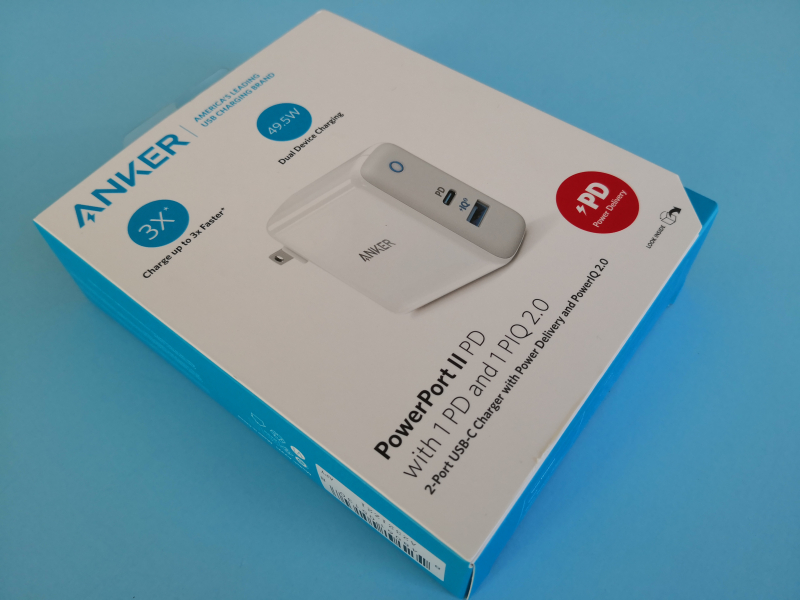
The Anker PowerPort II with Power Delivery charger claims on its box to output up to 49.5W when charging two devices in parallel.
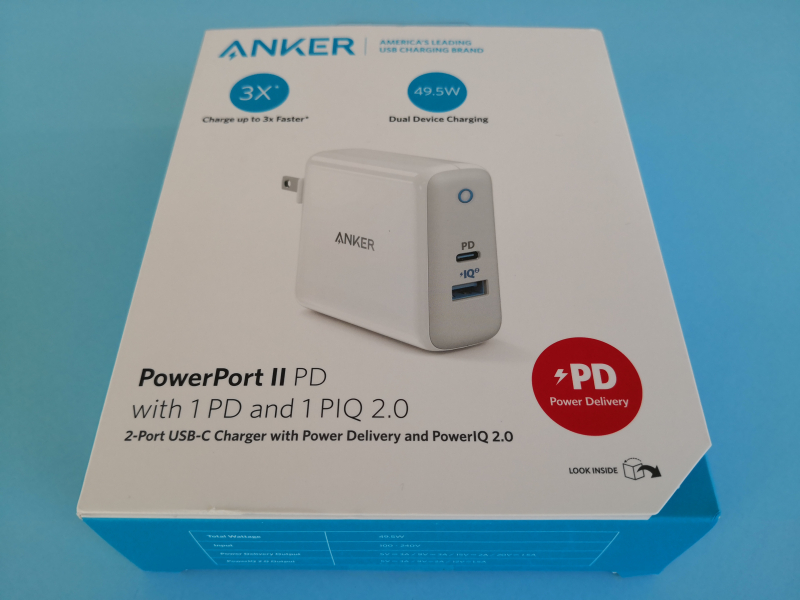
The Anker PowerPort II with Power Delivery box is designed nicely giving the charger a premium look.
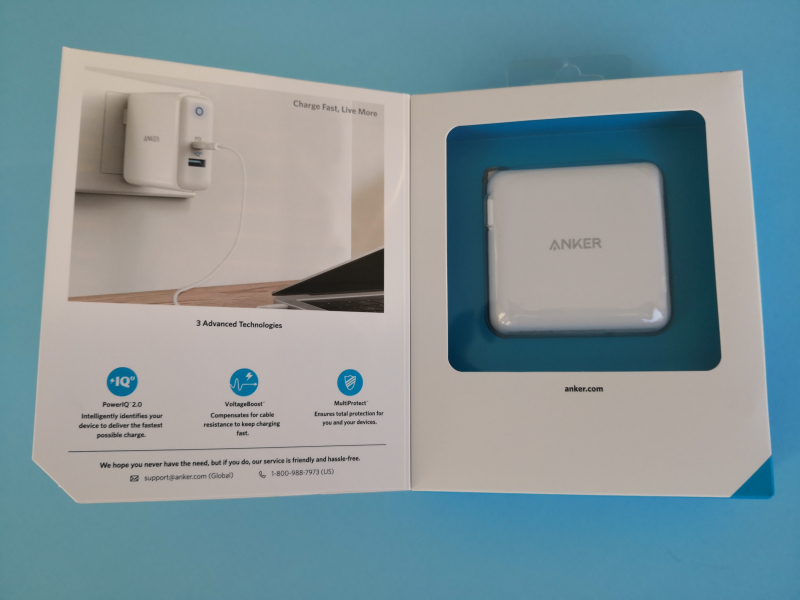
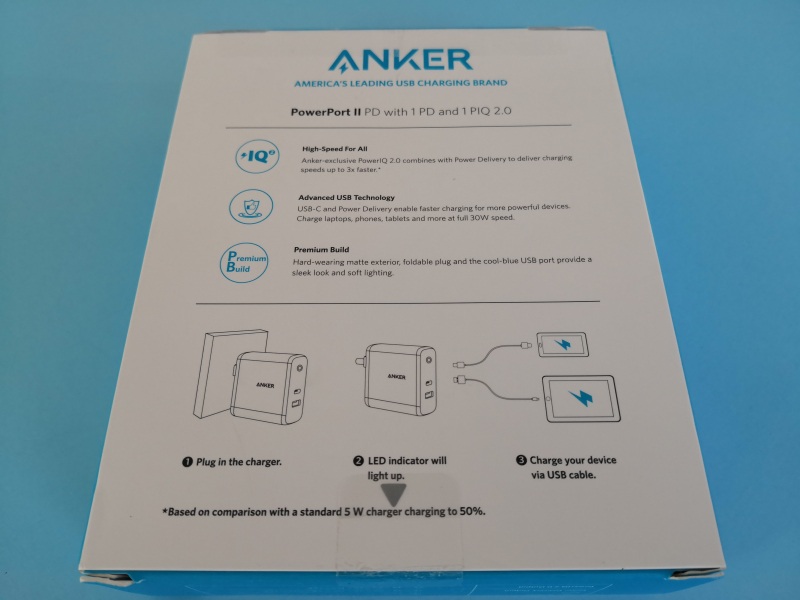

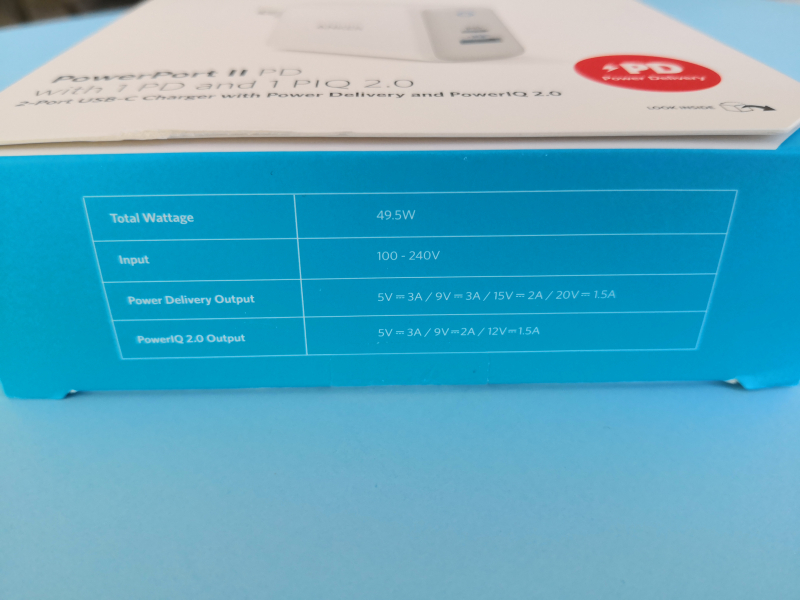
The Anker PowerPort II with Power Delivery charger also has a USB Type-A port that Anker claims to support 15 watts (5 volts @ 3 amps), 18 watts (9 volts @ 2 amps) and 18 watts (12 volts @ 1.5 amps) using its own proprietary PowerIQ 2.0 charging scheme.

There were no other accessories that came with the Anker PowerPort II with Power Delivery charger except for a instruction guide.
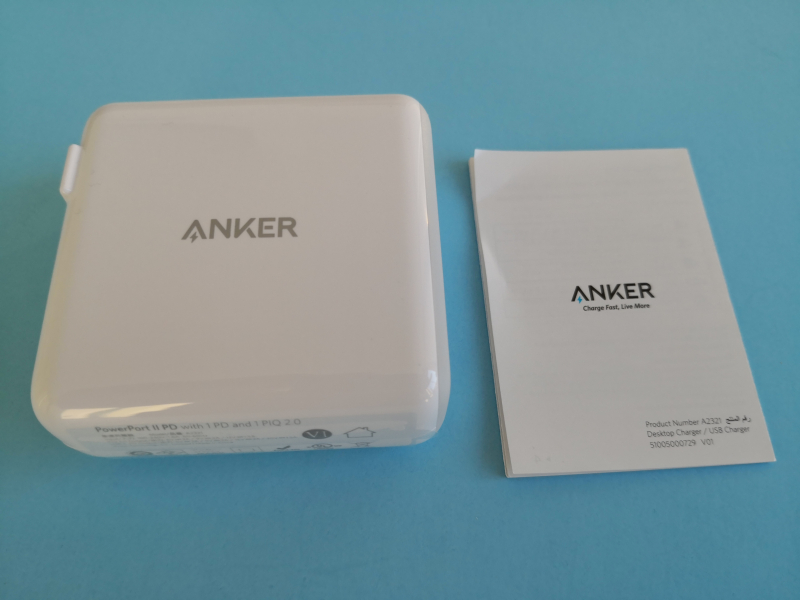
The charger has a compact design that matches Apple's look and feel and can be easily carried along everywhere.

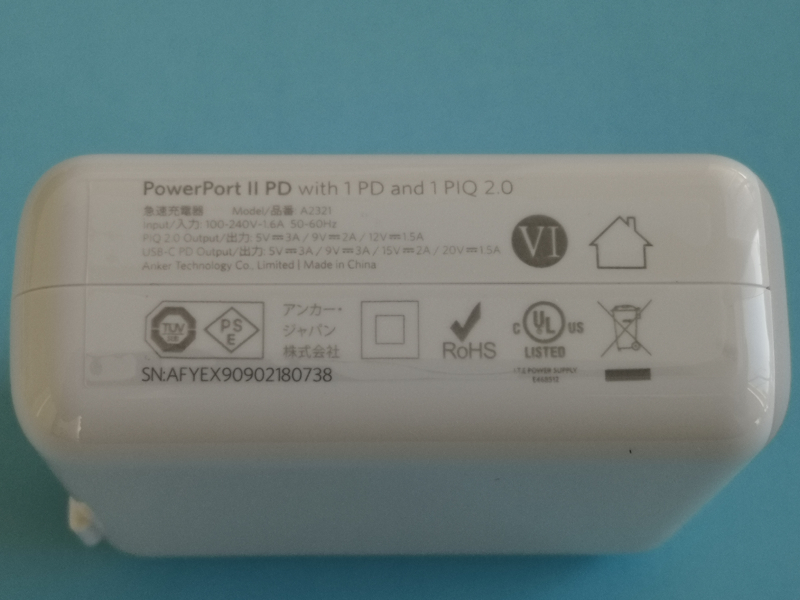
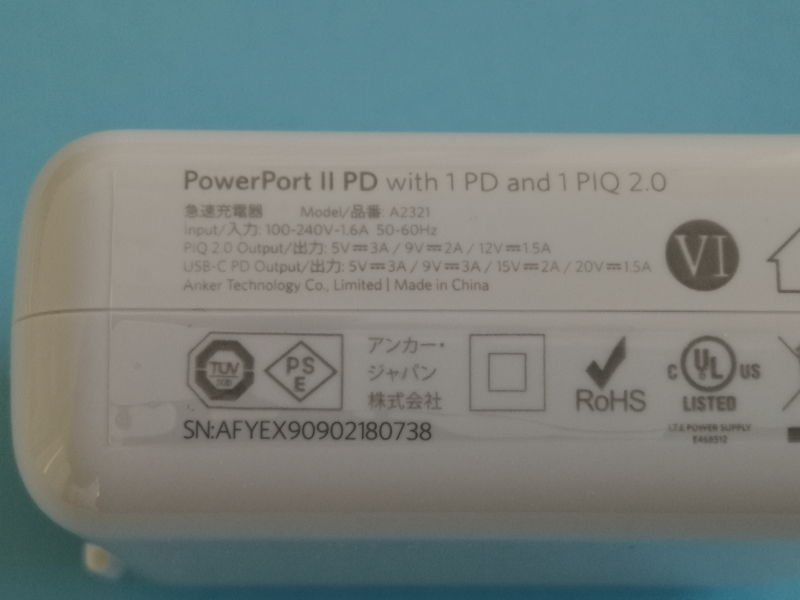
The Anker PowerPort II with Power Delivery charger also sports a charging indicator button on top of the USB ports.

For own power supply, the Anker PowerPort II with Power Delivery charger comes fitted with ac wall prongs for plugging into a ac wall socket.
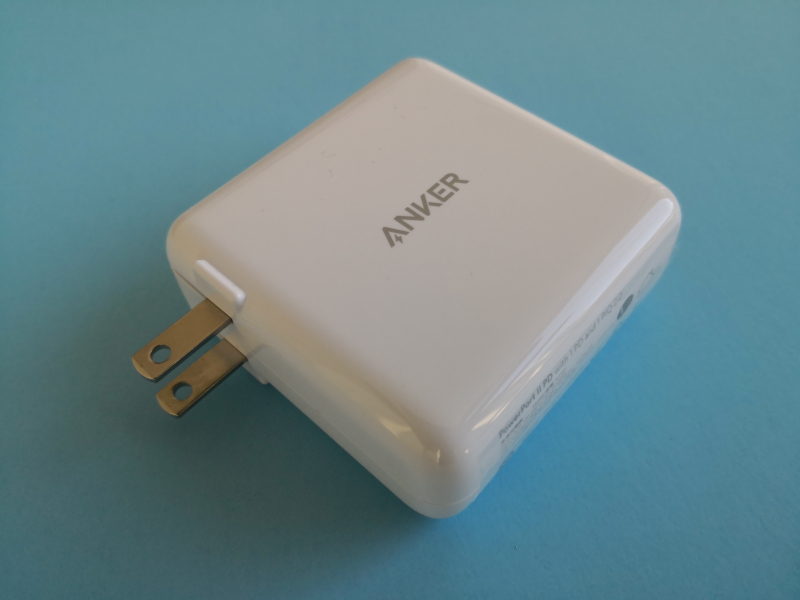
Using the USB Power Test App from Granite River Labs with the Granite River Labs USB Power Delivery Compliance C2 Tester, we generate the following test results for the Anker PowerPort II with Power Delivery charger to have a quick look at the charger's power capabilities.
The USB Power Test App first negotiates a power contract for every PDO supported by the Anker charger, and increases the load gradually to find the threshold where over current protection (OCP) kicks in and voltage and current start to drop for safety reasons.
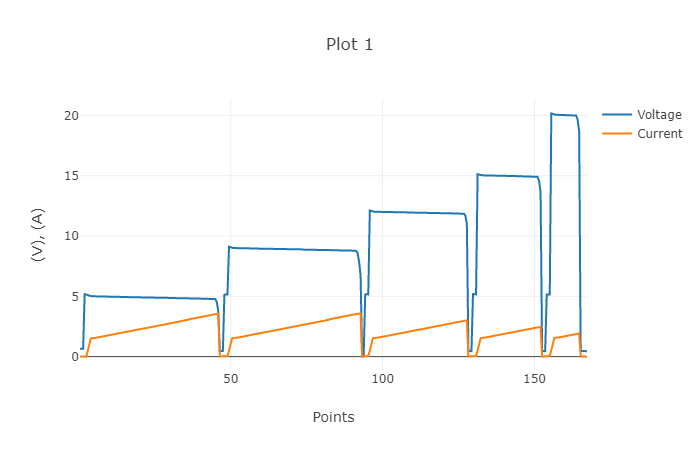
The USB Power Test App reports out all the PDO's supported by the Anker charger and their OCP thresholds. For some reason there's an additional PDO of 30 watts (12 volts @ 2.5 amps) not listed in the charger's specs.
| PDO | VAC | OCP (A) | %OCP | OCP Timeout (sec) | Voltage Drop(V) |
|---|---|---|---|---|---|
| PDO#1 Fixed: 5V 3A | 3.56 | 118.7% | 0.4 | 1.35 | |
| PDO#2 Fixed: 9V 3A | 3.57 | 118.9% | 0.4 | 1.6 | |
| PDO#3 Fixed: 12V 2.5A | 3.01 | 120.3% | 0.4 | 1.3 | |
| PDO#4 Fixed: 15V 2A | 2.47 | 123.4% | 0.4 | 1.85 | |
| PDO#5 Fixed: 20V 1.5A | 1.92 | 127.7% | 0.4 | 2.05 |
The USB Power Test App from Granite River Labs takes this data to produce an I-V curve which graphically shows the relationship between voltage and current for each PDO. Even though Anker does not specifically state that the Anker PowerPort II with Power Delivery charger supports PPS (Programmable Power Supply), we can observe current fold-back behavior where as the current increases beyond the OCP threshold, the voltage starts to curve down rather than immediately shutting off, which is the typical behavior of most PPS chargers.
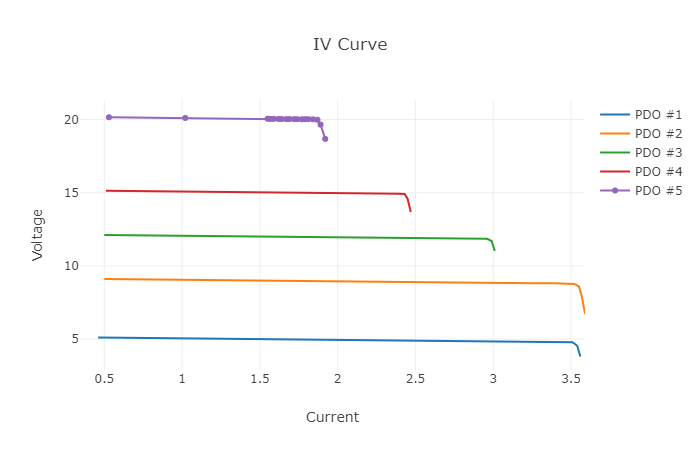
The USB Power Test App can also use the Granite River Labs USB Power Delivery Compliance C2 Tester integrated with the GW Instek APS-7100 programmable AC power supply to compare the charger's power output vs power input so that power efficiency can be measured and compared to regulatory limits from United States of Energy (DOE) Level VI or European Union's CoC Tier 2 requirements. We can repeat the power efficiency tests for different PDO's, current load conditions, and different AC input ranges, allowing us to get a complete picture of power efficiency ranges across all different usage scenarios.
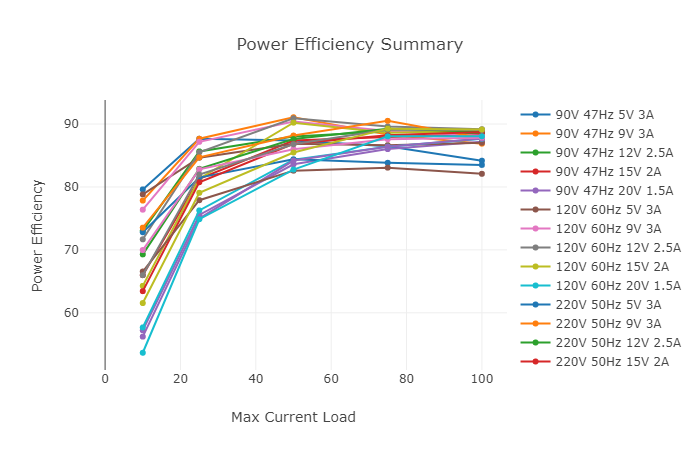
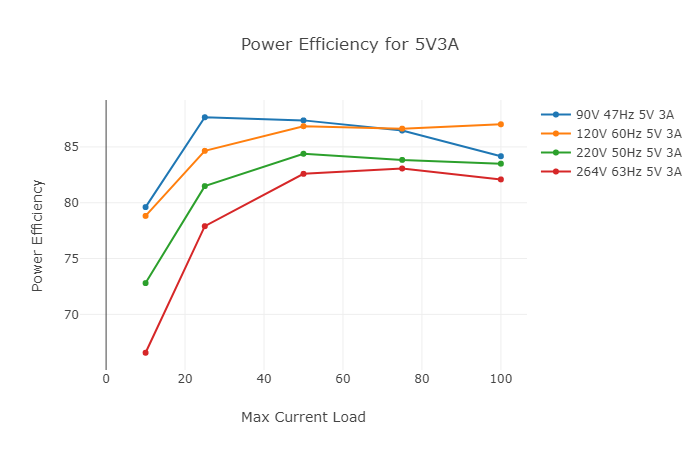

Using the USB Power Delivery Compliance C2 Tester from Granite River Labs to run just a subset of the full USB Power Delivery compliance test suite, some compliance failures were observed for the Anker PowerPort II with Power Delivery charger.
USB-IF High Level Mapping Summary
Sl No
|
Test Category
|
Test Group Description
|
Test Result
|
|---|---|---|---|
1
|
PHY_PRIMARY_TX
|
BMC Physical Layer Transmitter
|
PASS
|
2
|
PHY_PRIMARY_RX
|
BMC Physical Layer Receiver
|
FAIL
|
3
|
PHY_PRIMARY_MISC
|
BMC Physical Layer Miscellaneous
|
PASS
|
4
|
PROT_PRIMARY
|
Protocol Specific Primary
|
FAIL
|
5
|
POWER_PRIMARY
|
Power Source/Sink Primary
|
PASS
|
Result Summary
Sl No
|
Test ID
|
Test Name
|
Test Result
|
|---|---|---|---|
1
|
TDA.2.1.1.1
|
TDA.2.1.1.1 BMC PHY TX EYE
|
PASS
|
2
|
TDA.2.1.1.2
|
TDA.2.1.1.2 BMC PHY TX BIT
|
PASS
|
3
|
TDA.2.1.2.2
|
TDA.2.1.2.2 BMC PHY RX INT REJ
|
PASS
|
4
|
TDA.2.1.2.1
|
TDA.2.1.2.1 BMC PHY RX BUSIDL
|
FAIL
|
5
|
TDA.2.1.3.1
|
TDA.2.1.3.1 BMC PHY TERM
|
PASS
|
7
|
TDA.2.2.1
|
TDA.2.2.1 BMC PROT SEQ GETCAPS
|
PASS
|
8
|
TDA.2.2.2.1
|
TDA.2.2.2.1 BMC PROT SEQ CHKCAP P PC
|
FAIL
|
9
|
TDA.2.2.2.2
|
TDA.2.2.2.2 BMC PROT SEQ CHKCAP NOMARK P PC
|
PASS
|
13
|
TDA.2.2.7
|
TDA.2.2.7 BMC PROT BIST NOT 5V SRC
|
PASS
|
15
|
TDA.2.2.9
|
TDA.2.2.9 BMC PROT GSC REC
|
PASS
|
16
|
TDA.2.3.1.1
|
TDA.2.3.1.1 POW SRC LOAD P PC
|
PASS
|
17
|
TDA.2.3.2.1
|
TDA.2.3.2.1 POW SRC TRANS P PC
|
PASS
|
BMC Eye Diagram
We look forward to testing the Anker PowerPort II with Power Delivery charger on various USB PD products in the market.
View Full Article
USB PD Charging Technologies & Battery Life Benchmarking
Featured Products
 GTrusted
GTrusted


































